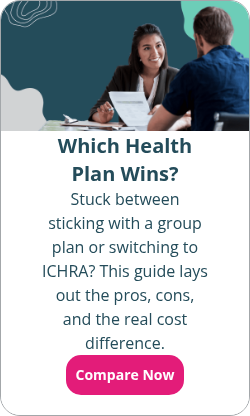Does the ICHRA satisfy the employer mandate?
By Elizabeth Walker on September 11, 2024 at 8:15 AM
If the federal government considers your organization an applicable large employer (ALE), you’re subject to specific Affordable Care Act (ACA) rules. Navigating the ACA can be difficult, especially if it’s your first time. But, understanding the employer mandate is especially important to avoid steep penalties.
The employer mandate requires ALEs to offer employee health coverage that meets specific affordability and value standards. Many ALEs think a traditional group health plan is the only way to satisfy the mandate. However, the individual coverage health reimbursement arrangement (ICHRA) can also fulfill the mandate and doesn’t require a group plan.
Before you offer an ICHRA, it’s vital to know how to design this employee benefit to comply with the ACA. This article will walk you through how the employer mandate and the ICHRA work. We’ll also explain how to use this HRA to satisfy the mandate’s requirements and avoid fines.
In this blog post, you’ll learn:
- What the employer mandate penalties are for 2025 and 2026.
- How the ICHRA works, and how ALEs can use it to meet ACA requirements.
- The criteria for ICHRA coverage, affordability, and minimum value.
What is the ACA employer mandate?
The employer mandate, also known as the employer shared responsibility provisions or the pay or play provisions, requires larger organizations to provide health coverage to their employees.
The employer mandate has been in effect since the federal government created the ACA in 2014, and was gradually rolled out through 2016. While there are other ACA rules, the employer mandate only applies to ALEs. ALEs are employers with 50 or more full-time equivalent employees (FTEs) during the previous calendar year.
ALEs must offer at least 95% of their full-time workers and their dependents affordable health insurance that meets minimum essential coverage (MEC) and provides minimum value. If not, they may be subject to potential penalties.
For 2025 and 2026, the penalties are as follows:
|
Who does it penalize? |
How much is the penalty? |
||
|
2025 |
2026 |
||
|
Section 4980H(a) penalty |
ALEs who fail to offer MEC to 95% of their full-time employees. |
$2,900 per full-time employee |
$3,340 per full-time employee |
|
Section 4980H(b) penalty |
ALEs who fail to offer affordable coverage that provides minimum value. |
$4,350 per full-time employee |
$5,010 per full-time employee |
For the first time, the IRS decreased the employer mandate penalties. These new, lower penalties will take effect for plan years beginning in 2025.
The IRS bases the Section 4980H(b) penalty on the number of employees who bought a health plan with premium tax credits. They decide the 4980H(a) penalty based on how many months your employees went without coverage during the previous calendar year. If you are in violation of Section 4980H(a) and Section 4980H(b), the IRS will fine you the greater of the two penalties, not both.
If you’re not an ALE, there’s no federal requirement to offer your employees health insurance coverage. You also won’t receive a fine for not doing so.
How does the ICHRA work?
The ICHRA is an IRS-approved, tax-free health benefit for organizations of all sizes. With an ICHRA, employers can reimburse their staff for individual health insurance premiums and qualified out-of-pocket medical expenses. Employers only need one W-2 employee to offer an ICHRA and can scale the benefit as their team grows.
ICHRAs are more personalized, cost-effective, and flexible than group plans. They have no minimum or maximum contribution limits. So, employers can offer their staff as much allowance as their budget allows. They also have no minimum participation requirements or annual rate hikes. This makes them more obtainable and cost-predictable for all types of employers.
Here’s how the ICHRA works:
- Employers set a monthly allowance. You decide how much tax-free money to give your employees to spend on healthcare. You can vary allowances by family status, age, or job-based employee classes.
- Employees buy qualifying health coverage. To participate in an ICHRA, your employees must have a qualifying form of individual health insurance. Their spouses and legal dependents can also participate in the benefit if they have proper coverage.
- Employees buy medical care. Employees pay for medical expenses upfront and out-of-pocket. IRS Publication 502 and the CARES Act have complete lists of eligible HRA items and services1. But you can also limit eligible items for reimbursement to premiums only.
- Employees submit proof of purchase. After buying an eligible expense, employees submit proof to their employer for review. Acceptable documentation is typically a receipt or invoice.
- Employers approve and reimburse the medical expenses. After reviewing the claim documentation to ensure it meets the proper criteria, you approve it. Then, you reimburse your employees tax-free up to their allowance amount. Reimbursements are free of payroll taxes for employers and income-tax-free for employees.
ICHRAs are an excellent coverage option for employers who want to avoid complex, time-consuming, and costly group plans. They let employees decide how and when they want to spend their money on medical care. This gives them more choice and freedom than a group plan.
Does the ICHRA satisfy the employer mandate?
Traditional group health insurance isn’t the only option for ALEs looking to satisfy the employer mandate. The ICHRA is a cost-effective and flexible way to help ALEs fulfill this requirement. But, the ICHRA can only satisfy ACA requirements if you design it correctly. Let’s go over how to do this in the sections below.
Minimum essential coverage (MEC)
ALEs must offer at least 95% of their employees health insurance that meets MEC. Because the ICHRA allows employees to choose an individual health plan, they must enroll in a policy that meets MEC to participate in the employee benefit. The HRA allowance you offer will help them pay for their chosen health plan’s monthly premium.
|
Acceptable health plans under an ICHRA |
Health plans that are incompatible with an ICHRA |
|
Qualified individual plans from a public exchange. Public exchanges are the federal Health Insurance Marketplace or a state-based marketplace. |
Traditional group health plans, including a spouse’s or parent’s group policy, don’t work with an ICHRA. While these plans often meet MEC standards, they aren’t individual plans. |
|
Individual plans from a private exchange also qualify as long as the policy meets MEC with no annual or lifetime limits. A private exchange is an insurance company or a broker. |
|
|
Medicare Parts A and B together qualify as individual coverage with MEC. |
|
|
Medicare Part C, also known as Medicare Advantage plans, also qualify. |
|
|
Student health insurance plans, except for self-insured student health coverage, also qualify. |
|
|
TRICARE |
If you offer an ICHRA through PeopleKeep, our platform helps your employees enroll in a health policy that meets MEC standards.
Employees must have qualified individual health coverage to participate in the ICHRA. But you must offer an affordable HRA allowance to fulfill the next part of the employer mandate.
Affordability
Under the ACA, employers offering an ICHRA must provide at least 95% of their full-time employees with an affordable allowance. In 2025, a health plan was affordable as long as employees paid no more than 9.02% of their annual household income for health insurance. For 2026, this increases to 9.96%.2
To calculate affordability, use the cost of the lowest-cost silver plan for a non-tobacco user on a public exchange. The exchange you’ll use will be the federal marketplace or your state’s marketplace if they have one. Then, subtract your ICHRA allowance from the plan’s insurance premium. If the remaining amount doesn’t exceed 9.96% of an employee’s household income for the month, the federal government considers the ICHRA affordable.
But if the amount is more than 9.96%, the ICHRA is unaffordable. So, if at least one employee who’s eligible for premium tax credits accepts their subsidy, you’ll be subject to a penalty.
It’s unlikely you’ll know every employee’s personal household income. So, to help you determine affordability, the federal government allows you to use safe harbors.
According to the IRS, business owners can use the following safe harbors to determine ICHRA affordability43:
- Geographic location: With this safe harbor, employers can use the employee’s primary employment site to determine the insurance rating area and affordability.
- Household income: Also called the affordability safe harbor, employers can estimate an employee’s income using their Form W-2 wages, pay rate, or the federal poverty level.
- Look-back: Employers can use the price of the lowest-cost silver plan from the previous calendar year to calculate their ICHRA’s affordability for the following year.
The most popular safe harbor for affordability determination is the federal poverty line test. Under this safe harbor, your ICHRA is affordable as long as employees aren't paying more than $129.90 monthly for their medical insurance in 2026.
Suppose your allowance meets affordability guidelines under the safe harbors, but you still have employees with an unaffordable allowance. In that case, they can opt out of the ICHRA and collect their premium tax credits if they qualify for them. In this case, using safe harbors protects you from the penalty.
But if an employee has an affordable allowance and opts out of the ICHRA anyway, they’ll still be ineligible to receive their credits.
Minimum value
Like MEC, employees with an ICHRA must also ensure their chosen individual health plans provide minimum value to satisfy the employer mandate.
A health plan meets the minimum value requirement if both of the following apply:
- The plan pays at least 60% of the total cost of medical services for the standard population.
- The plan’s benefits provide substantial coverage for physician and inpatient hospital services.
Luckily, most acceptable MEC plans employees can choose already meet minimum value standards. For example, any major medical plan an employee buys on the public exchange meets this rule. But let’s look at some that don’t.
The following plans don’t provide minimum value coverage for ICHRAs:
- Short-term health plans
- Healthcare sharing plans
- TRICARE medical coverage
Employees enrolled in one of these plans can’t participate in an ICHRA. However, offering an ICHRA mid-year triggers a special enrollment period. This means these employees can cancel their current plan and buy a qualified health plan on the public or private marketplace to take part in your ICHRA. Or they can opt out of the ICHRA if their allowance amount is unaffordable and buy a different health plan altogether.
Conclusion
Understanding the employer mandate can be challenging. But with the right health benefit, you can avoid the penalties without complications. Instead of buying a group health plan, an ICHRA is a simpler option to help you meet ACA requirements and save money on your benefits budget. Better yet, your employees have access to a flexible health benefit that can help them control their finances and healthcare.
If you want to offer an ICHRA at your organization, PeopleKeep can help! Our HRA administration software makes it easy to design and manage an affordable ICHRA to comply with the employer mandate. Schedule a demo today with an HRA specialist or learn more.
This article was originally published on June 11, 2019. It was last updated on September 11, 2024.
Check out more resources
See these related articles

Pros and cons of the individual coverage HRA
Considering an individual coverage HRA (ICHRA)? Discover the pros and cons of this healthcare option to make an informed decision.

What to expect when your employer offers you an ICHRA
Curious about ICHRAs? Discover what to expect when your employer offers you an individual coverage health reimbursement arrangement with this guide.

Who is eligible for the individual coverage HRA (ICHRA)?
Find out who qualifies for the Individual Coverage HRA (ICHRA). Explore ICHRA eligibility rules and how they benefit both employers and employees.



